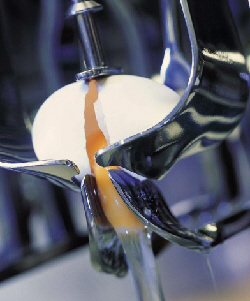



Future of Egg Products Linked to Health Issues
Global output of egg products in 2012 is estimated to be around five million tonnes by industry watcher, Terry Evans.Population growth coupled with improvements in real incomes, particularly among the poorer sectors of communities, virtually guarantees an annual expansion in hen egg production.
While the global human population increased by just over one per cent a year from 6,122.8 million in 2000 to 6,895.9 million in 2010, hen egg production expanded by more than two per cent a year from 51.0 million tonnes to 63.8 million tonnes. However, it should be noted that these figures (see Table 1) include a percentage of hatching eggs estimated globally to be around five per cent.
| Table 1. World hen egg production and estimated egg products output (million tonnes) | |||||||||||
|---|---|---|---|---|---|---|---|---|---|---|---|
| Region | Hen egg production | Egg products | |||||||||
| Region | 2000 | 2005 | 2006 | 2007 | 2008 | 2009 | 2010 | 2011P | 2012E | 2013E | 2012E |
| Africa | 1.9 | 2.2 | 2.4 | 2.5 | 2.6 | 2.5 | 2.7 | 2.7 | 2.8 | 2.8 | - |
| Americas | 10.4 | 11.7 | 12.3 | 12.3 | 12.5 | 12.8 | 12.9 | 13.2 | 13.2 | 13.2 | 2.10 |
| Asia | 29.0 | 32.6 | 33.0 | 34.5 | 36.3 | 37.0 | 37.6 | 38.2 | 38.4 | 38.6 | 0.80 |
| Europe | 9.5 | 9.9 | 10.1 | 10.0 | 10.1 | 10.3 | 10.4 | 10.6 | 10.6 | 10.6 | 2.00 |
| Oceania | 0.2 | 0.2 | 0.2 | 0.2 | 0.2 | 0.2 | 0.3 | 0.3 | 0.3 | 0.3 | 0.03 |
| WORLD | 51.0 | 56.6 | 57.9 | 59.6 | 61.7 | 62.8 | 63.8 | 65.0 | 65.3 | 65.5 | 5.00 |
| P=provisional; E=estimate; - no figure available Sources: FAO for 2000 to 2011; the author's estimates for 2012 and 2013 |
|||||||||||
There are no official figures for the production of egg products. An estimate for 2012 is presented in the table, pointing to a global total of around five million tonnes.
Although output will have expanded during the past decade or so, the annual increases are not likely to have been as consistent as those for shell eggs. Product production will have varied from year to year not only in relation to changes in the demand from food processors for the various forms of egg products but also with changes in the available supplies and prices at which egg product manufacturers can obtain eggs for breaking.

While, in general, the volume of egg product production depends upon the quantities and prices of surplus table eggs from the conventional shell market, the expansion in the demand for egg products, especially in developed economies, is putting this sector of the egg industry on a firmer footing, and indeed, in some countries, and particularly in the US, large laying units have been established to supply eggs solely to egg processing plants. A guide as to how the market for egg products has widened is given in the claim by the US company, General Mills, that it markets egg products in some 100 countries and that, in the two years since January 2010, it has launched more than 800 egg-related products.
In addition, the past decade has witnessed a significant increase in the number of uses for egg products outside of the traditional baking/food manufacturing sectors, with more products being used for the production of nutritional as well as health-related and medicinal items. Indeed, there is a view that the health/nutritional benefits of egg products may be key to future growth of the egg products sector.
With limited official data on egg product production, the figures presented here are best estimates and in some instances, little more than educated guesswork. Looking specifically at 2012, hen egg production is likely to have been around 65.3 million tonnes which, after deducting an estimate for hatching eggs, puts table egg output at some 62 million tonnes.
* "The health/nutritional benefits of egg products may be key to future growth of the egg products sector" |
It is considered that there are about 350 egg processing plants worldwide and that in 2012, they had an estimated capability of producing around five million tonnes of egg products (expressed as shell egg equivalent). This would equate with some eight per cent of the global total for all table eggs. However, it should be noted that there can be a considerable difference between processing capacity and actual plant output depending on local conditions in the shell egg market, as some breakers may have had to operate at less than their full plant capacities.
Europe is the largest producer of egg products with the ability to utilise some two million tonnes of shell eggs a year, equivalent to around 19 per cent of table egg output. The bulk of production comes from some 100 or so plants sited in European Union countries, which can produce more than 1.6 million tonnes of products a year, equivalent to almost 25 per cent of table egg output, a figure which, according to Filiep Van Bosstraeten, CEO of Ovobel Ltd, could rise to between 30 and 35 per cent by 2015.
Within the EU, the Netherlands is the largest manufacturer of egg products with an annual output approaching 240,000 tonnes which, when related to table egg production, is high at around 36 per cent or more, as significant quantities of products are manufactured from imported shell eggs.
France is the second largest producer in the Community product output representing about 25 per cent of total production. Spain and the UK are the other major products manufacturers, output representing about 17 per cent of production in the UK and some 14 per cent in Spain.
In stark contrast in the two largest European egg processing countries outside the EU, Russia and the Ukraine, the proportion of table eggs converted into products is well below below two per cent.
North America is the second largest egg products-producing region, with some 60 factories having a combined annual output of about 1.7 million tonnes shell egg equivalent, of which nearly 90 per cent will have been manufactured in the US, the remainder being produced in Canada. US products represent between 27 and 28 per cent of table egg production, while the corresponding figure for Canada is around 25 per cent. In some years, around 30 per cent of US table eggs have been converted into products and it has been confidently predicted that the figure will rise substantially in the foreseeable future.

In the whole of Central and South America, there are fewer than 40 products manufacturers with a combined annual output approaching 400,000 tonnes representing almost seven per cent of table eggs. More than 70 per cent of this region's total is manufactured in Mexico, Brazil and Argentina. Around 13 breakers in Mexico have a combined capacity of around 175,000 tonnes (about eight per cent of shell eggs) a year. Brazil has a similar number of processors handling about 100,000 tonnes a year, or six per cent of total egg output after having adjusted for a particularly high percentage of hatching eggs for the broiler sector. Argentina has some 10 plants capable of producing around 80,000 tonnes - about 16 per cent of egg output.
Although egg processors in Asia have the capacity to turn some 800,000 tonnes of eggs into products, this represents only about three per cent of table egg production. In most of the countries in this region, the proportion processed is generally no more than one per cent although there are a few notable exceptions namely Japan, Korea and Taiwan.
Japanese processing plants produce some 500,000 tonnes a year or 20 per cent of its table egg production. However, in addition, approximately 750,000 tonnes of domestic shell eggs go to the hotel, restaurant and food-service sectors, of which a large proportion are broken in-house for food dishes or fast-food products. Hence, approximately 50 per cent of Japan's egg production ends up in some form of egg products.
The corresponding percentages for Taiwan and Korea are 15 per cent and eight per cent, respectively. However, it must be appreciated that utilisation of just one per cent in the massive egg-producing country of China still represents an egg products output of more than 200,000 tonnes a year, a figure which relates to only 18 factories and does not include the production from in-house plants owned by food industry companies.
The author is indebted to Morten Ernst of Sanovo International and Filiep Van Bosstraeten of Ovobel for their help in the preparation of this article.
March 2013








